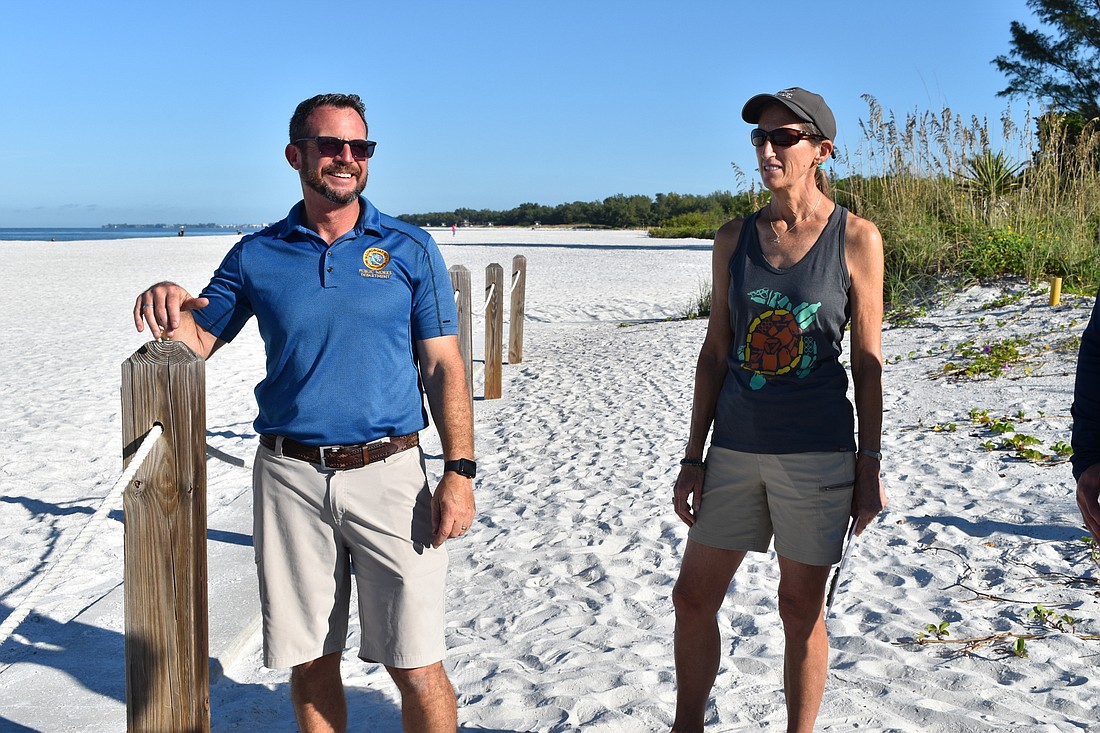- April 18, 2024
-
-
Loading

Loading

Longboat Key Turtle Watch Vice President Cyndi Seamon says she’s seen gulf-front property owners make pre-emptive changes to abide by the town’s revised sea turtle protections set to take effect next year, even though the town has yet to deliver its first public outreach on the topic.
“I have heard people saying that they were making sure that their board is aware of it,” Seamon said. “They’re going to try and make sure everybody knows about these meetings.”
The town is scheduled to hold a series of one-hour meetings on Dec. 20 2021; Jan. 21, 2022 and March 14, 2022, at Town Hall. Planning, Zoning and Building Director Allen Parsons said each meeting will provide the same information.
The Dec. 20 session is available on Zoom.
The town’s new sea turtle protections take effect on Jan. 2, 2022, by law, but they are applicable during turtle season from May 1-Oct. 31.
“It’s our responsibility,” code enforcement officer Chris Kopp said. “I mean, the turtles were here first. We’re not trying to affect anybody’s quality of life. All we’re trying to do is coexist with the sea turtles that have been here for hundreds of thousands of years.”
The updated regulations address exterior lighting, items left on the beach at night, building, permitting and inspection requirements, prohibited activities and more.
“I think we can coexist here,” Kopp said. “We just need to make sure that we, as the humans, are being responsible and taking care of the animals that can’t do it for themselves.”
Specifically, here are some of the changes to Chapter 100 of the Town Code:
Kopp said he believes the biggest changes are the new turtle-friendly bulbs and the recreational-use agreement.
The ordinance says “turtle-friendly bulbs” must be certified by the Florida Fish and Wildlife Conservation Commission or a bulb that produces only long-wavelength light.
“Any of the upland property owners want to store items out on the beach such as lounge chairs and umbrellas,” Kopp said. “They can continue to do so, however, they’re going to need this new recreational-use agreement submitted to the town, which just allows us to know what is out on the beach (and) where it’s being stored so that we can all make sure it’s being stored properly.”
Kopp said the town has already received a recreational-use agreement from the Vizcaya at Longboat Key. The condominium complex was the first to submit a new recreational-use agreement.
Mote Marine Laboratory & Aquarium data shows a lower rate of sea turtle disorentiations in 2021 compared to the eight-year average. However, Seamon said it comes with the caveat of relocating many nests due to the town’s beach renourishment projects.
“Our disorientations were down, which is great, but this year was so weird because we relocated so many nests,” Seamon said. “Then, those nests were all caged. It’s got to have a little asterisk next to it, right? Because if I was going to relocate a nest, I didn’t put it someplace where I thought there was going to be a light problem.”
Kopp believes the relocations contributed to lower disorientation rates, but said he looks at other data as well.
“The number I don’t have and another important number to look at is the survival rate because when we relocate nests or Mote relocates nests, the survivability actually goes down,” Kopp said. “And, they try to relocate these nests in the most optimal points.”
Mote Marine senior biologist Melissa Bernhard provided a presentation in mid-November that showed crews moved 111 nests or about 10,863 eggs because of Longboat Key’s beach projects.
Among Longboat Key, Lido Key, Siesta Key, Casey Key and Venice in 2021, Bernhard said about 2,665 nests had at least one egg hatch, which is about 70.4% of the nests.
In 2021, Mote counted 75,204 hatched eggs in excavated nests among the five beaches. There are about 170,485 total hatched eggs.
Also, Mote counted 117,168 eggs laid in 1,211 nests this year. It estimates there were 260,870 total eggs laid. Bernhard estimated about 65.4% of the sea turtle eggs hatched in 2021. She also estimated that there were about 324 total nests lost due to storms this year.
FWC data shows Longboat Key has a higher disorientation rate than many of the surrounding areas, which is the reason for the town’s new rules. Longboat Key’s approximate 10.5 miles of shoreline is larger than many other nearby coastal areas.
“There (are) so many contributing factors,” Kopp said. “Like I mentioned before, the lighting technology. Our population growth is skyrocketing and as I mentioned, government and our rules and our regulations and our codes always seem to be playing catch up.”
Kopp explained the reasoning for the new rules.
“We now see the unfortunate numbers of disorientations going up, and it’s our duty as the town, the state and federally to protect these turtles, and that’s why there was a need to update this ordinance,” Kopp said.
Kopp said the town will examine the Mote and FWC data in the next several years to determine the ordinance’s effectiveness.